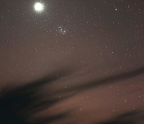Orion’s StarShoot G16 Deep Space Camera

Orion StarShoot G16 Deep Space Mono Imaging Camera with Orion StarShoot 2” Filter Wheel and LRGB Filter Set package
US p0rice: $1,299.99 (camera), $629.99 (filter wheel with LRGB filters) telescope.com
What we like
Small, sensitive pixels
Attractive pricing
What we don’t like
Filter-wheel software independent of camera control
No mechanical shutter
IF THERE WAS EVER ANY DOUBT about the popularity of astronomical imaging today, you only have to look at the range of new cameras being produced by several vendors, including Orion Telescopes & Binoculars in California. Orion has long offered beginner and intermediate-level astronomical cameras, including both one-shot-colour and monochrome models suitable for deep sky imaging as well as lunar and planetary photography.
Orion recently introduced the StarShoot G16 Deep Space Mono Imaging Camera. This thermoelectrically cooled, deep sky imager features a 4/3-format, 16-megapixel Panasonic MN34230 monochrome CMOS detector with 3.8-µm pixels in a 4,640 x 3,506 array measuring 17.6 x 13.3 mm, or 22.1 mm corner to corner. For this review we borrowed the G16 along with
You’re reading a preview, subscribe to read more.
Start your free 30 days

